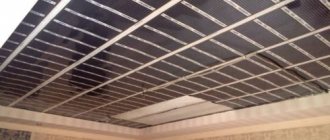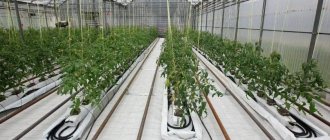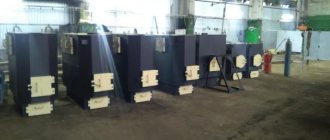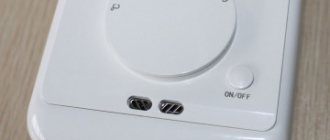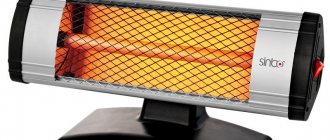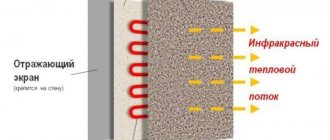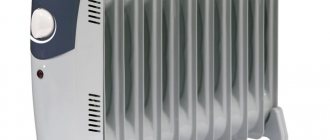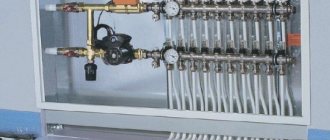A greenhouse is indispensable for obtaining a good harvest of greens, berries or vegetables in a minimum period of time. And if you intend to always have natural vitamins on your table that are found in fruits and vegetables, then you will need infrared heating of greenhouses.
As practice shows, one of the best heating systems for a greenhouse or greenhouse is infrared heating. It is perfect for growing various plants in greenhouses at any time of the year. An IR heater makes it possible to effectively warm the air and soil to the desired temperature.
Of course, other heating options can also be used for these purposes. For example, a convector, a gas heating boiler, a wood stove, water heating. But all these methods are associated with significant expenditures of effort, time and money required for their installation and maintenance. IR heating does not have these disadvantages.
Peculiarities
Attention: The main feature of the infrared heating system is that it does not heat the air itself in the greenhouse, but the plants and soil that are located in the radiation field. This radiation is much like solar energy. After all, the heated earth, sprouts and other objects emit peculiar photons, which are reflected back by the walls of the greenhouse.
This is precisely the main difference between this method of heating greenhouses and all others. After all, other methods only increase the temperature of the air that rises. They do not warm the soil and shoots. Of course, this can be corrected thanks to water pipes that should be buried in the ground. But then the cost of such a greenhouse heating system will increase significantly. In addition, controlling soil temperature will be much more difficult.
By installing an infrared heating system for a greenhouse, you will achieve rapid germination, development and fruiting of plants, since the direction of radiation will be from top to bottom. According to numerous studies, it has been proven that with such heating, seed germination increases by almost 30-40%. This is possible precisely due to good soil heating. At the same time, the air in the greenhouse does not heat up much, which is a positive factor.
Some infrared heating devices can also be placed under a layer of soil. But for this you will need to use a special IR film.
How to use infrared emitters correctly
Thanks to its mobility, ease of installation and connection, installation work can be done without the help of specialists. But then you will have to take advantage of the accumulated experience of others who, over the years of operation, have managed to learn all the intricacies of their operation and management.
Heat distribution diagram in a greenhouse with convector and infrared heating.
Using more powerful devices
With this option for using infrared heating, it is assumed that units with a power of 500 watts will be used. The distance from plants to equipment must be maintained at more than 1 m. In those parts of the premises where the lowest temperature is observed, such powerful devices will successfully cope with their work. That is, it is better to place them near windows or walls.
Heaters equipped with a special ceiling mount are more convenient to use. They are convenient to hang over a table with seedlings. It is quite difficult to determine exactly at what height the device should hang. This will have to be clarified only experimentally from your own experience. Having adjusted the equipment to the desired distance, it is not changed until the vegetable crops begin to grow. With their growth, which is already becoming noticeable to the eye, the device is raised higher.
One unit will be for every one and a half to three meters of area. The scale of the greenhouse and the height at which heaters are hung will influence the choice of the specific distance between units. A larger area will be covered by the heater when it is located higher. Whenever possible, infrared equipment should be hung as high as possible, so that fewer units will need to be installed.
It is important to consider here that the higher the heater is located, the less heat the plant receives. Therefore, the level of comfort for seedlings should be given higher priority than savings.
Distribution diagram of IR heaters throughout the greenhouse.
Using lower power heaters
Using a 250-watt heater is the second option for using an infrared heating system. You need to use more devices to get the desired effect. Therefore, the distance between the units should be maintained no more than one and a half meters. As for the level of their placement above the plants, this will also have to be established only in practice.
The position of the heaters must be left stable until the seedlings grow, as in the previous option. They are raised gradually, following the growth of seedlings. The small dimensions and weight of such a heater provide certain ease of use. There is enough wire to hang the device.
There are a few tricks you can use to help you get the most out of your infrared heating. For example, placing heaters in a checkerboard pattern will increase the heat transfer of the equipment, which will help save energy. The number of “dead” zones is minimal. This advice would be appropriate for cases where it is necessary to heat the entire area of the greenhouse evenly. If heat sources are needed only in certain areas, then heaters are hung directly in them.
Advantages
In terms of their effects, IR systems resemble solar energy. With their help, the desired temperature is created directly in the plant growth zone. This is how they differ significantly from convectors for the better. After all, they heat the air that rises, while the sprouts remain cool.
The main task of an infrared heating system is to heat plants, soil, shelving, greenhouse walls and containers with seedlings.
Attention: The loss of efficiency with this type of heating does not exceed 10%.
Water heating of the greenhouse also gives a good effect. But there are difficulties with installing the pipeline. After all, it must be laid in the ground, and this takes a lot of time and effort. In addition, this heating method is quite expensive. Infrared heating is superior in two important indicators - mobility and energy saving. It also provides an opportunity to save a lot of money.
Among the advantages of infrared heating of greenhouses are the following:
- destruction of various viruses and bacteria that negatively affect sprouts;
- uniform heating of all plants and soil;
- positive effect on the development and growth of plants;
- creating a humid microclimate in the greenhouse, since the air does not dry;
- long service life and reliability;
- significant increase in yield.
All of the above advantages make infrared heating of greenhouses quite popular and the demand for them is always great. Although a lot depends on the climate. After all, if winters in the region are usually too cold, then heating will have to be done in a different way, since IR radiation may not be able to maintain the desired temperature in such conditions.
Advantages inherent in infrared heaters
- uniform distribution of heat in the required area of the greenhouse;
- help get rid of drafts;
- opportunity to save energy;
- have a beneficial effect on plant growth;
- the growth of pathogenic bacteria and viruses is suppressed;
- high practicality.
Diagram of a ceiling infrared heater.
Let us dwell in more detail on each of the advantages.
Unlike convective heating systems, from which warm air tends upward and cold air accumulates at the bottom of the greenhouse, heat distribution with infrared heaters occurs differently. Uneven temperature distribution is excluded with them. Plants are sufficiently provided with the necessary heat due to the fact that heat loss is minimal.
Many representatives of the flora are too sensitive to drafts; infrared heaters help cope with this problem. For these purposes, the device is placed in an area where thermal insulation is reduced (for example, near windows). Without forming air flows, it compensates for heat losses.
The practicality of the IR heater lies in the fact that it can be used to create thermal zones with different characteristics for growing vegetable crops with different growing conditions under one roof. This directly relates to efficiency, since greenhouses are not heated completely, but only a certain part of them. Correct installation and operation of devices can reduce energy consumption by up to 40%. They work without creating noise, which is important for both plants and humans. IR heaters are compact, mobile, and do not take up much usable space (floor and walls), which is highly valued in a greenhouse. They are easy to install and remove from the ceiling space. The height of suspended infrared equipment will depend on the temperature to which the soil needs to be heated. When growing seedlings, the IR equipment descends lower to the plants, and as they grow, it rises. They do not dry the air, which is important for greenhouse conditions.
What is this device capable of? According to experienced gardeners, seed germination increases significantly (by about a third). This is due to the fact that IR heaters, warming the soil by 5-7 centimeters, stimulate the root system of plants, creating all the necessary conditions for root growth. Other heating devices cannot provide a similar effect of targeted soil heating. Infrared radiation can heat the soil to a temperature of +28 degrees, which is optimal for plants. And the air heating remains at +21°.
Equipping a greenhouse with an infrared heating system
Attention: There are three types of infrared greenhouse heating system: suspended, mixed or recessed. Its choice depends on the needs of the greenhouse owner. If the greenhouse is planned to be used only in the warm season, and it is needed for growing only heat-loving plants, only hanging IR heaters will be sufficient.
Complex infrared heating systems are suitable for floriculture and vegetable growing throughout the year. If you are using a greenhouse for early growing of greens and seedlings, then to warm the soil you should use a buried system that should be laid in the ground.
Tips for use
The experience gained by gardeners and gardeners during the operation of IR heaters in greenhouses allows us to draw certain conclusions regarding their use:
- with proper operation of such a heating source for greenhouse plantings, the germination rate of seedlings increases by 40%;
- with the help of infrared rays it is possible to maintain optimal humidity and a favorable microclimate in the greenhouse at elevated temperatures, since IR radiation does not dry out the air;
- with the help of the correct location of IR equipment, it becomes possible to warm the soil to a depth of 7 cm, which cannot be achieved with other types of heaters;
- With the help of these devices, it is possible to warm the soil up to +28°C so that the air temperature in the greenhouse does not exceed +21°C.
Important! For small greenhouses, it is advisable to use long-wave gas infrared equipment.
An efficient and gentle microclimate in the greenhouse, the infrared gas heater is distinguished by the availability of the fuel used and ease of maintenance. When designing a heating system for greenhouses, more and more gardeners are giving preference to this particular device.
Suspended heating
The simplest type of infrared heating of a greenhouse is the use of suspended systems. They should be hung from the ceiling or walls of the greenhouse and connected to an energy source and directed to the beds. Due to their compactness and low weight, they can be installed in a greenhouse for as long as needed. It all depends on the area of the structure and their power. Heaters or lamps can be used as hanging systems.
Heaters and lamps are equally resistant to temperature changes, mechanical stress, high air humidity, and various chemical reagents. It is recommended to install the IR heater at a height of at least 1 meter from the plants. The height can be determined more accurately based on the size of the greenhouse and the temperature required for good plant growth. One should also take into account the fact that the higher the IR heating system is located, the larger the area it will be able to cover. But at the same time, the plants will receive less heat.
Also read: How to make a winter greenhouse yourself?
The best devices for greenhouses
If you choose the best models for use in greenhouses, you need to remember that they are installed in order to minimize human presence in the process. They must first of all create ideal conditions for the rapid growth of vegetation.
will allow you to choose the best unit :
- By appointment. There are units for industrial purposes, and others for household purposes. The latter are used in small country greenhouses. But industrial ones are also sometimes used in greenhouses of country houses. Although they contribute to the rapid growth of plants, the short-wave spectrum negatively affects human health.
- Type of fuel used. It all depends on the size of the premises and the price of gas and electricity. In each individual case, it is necessary to calculate which devices will be more profitable to use. As practice shows, the use of electric heaters in large rooms is unprofitable; it is better to give preference to gas options.
- Light and dark heating elements. The experience of gardeners shows that the use of light heaters, which can have a temperature of about 600 degrees, is justified as the main heater for the entire room in the winter season. Dark (less powerful) ones are best used for heating small areas.
- Mounting type. Industrial models are usually mounted on the ceiling, while household models are mounted on special stands or on the wall.
- Performance. Before purchasing IR devices, you should correctly calculate the required area for heating. Productive models can warm the soil up to 100 square meters, and household ones - up to a maximum of 20.
IR heater
The heaters are IR ceramic emitters enclosed in a protective casing. To achieve high-quality beam distribution, it is equipped with a reflector. Thanks to the presence of a mounting block with a cable, connecting the heater is simple and convenient. Installing this device will not cause any difficulties. You just need to follow the recommendations specified in the instructions.
Heating of the greenhouse with hanging infrared heaters should be carried out at a distance of 1.5 - 3.0 meters from each other. But the distance largely depends on their power, dimensions, temperature in the greenhouse and their height above the beds. If it is freezing outside, infrared heaters should be directed at the walls of the greenhouse.
Classification
Infrared heating devices differ in the sources of energy released, types of heating elements, installation methods and some other characteristics.
You will be interested in learning how to heat a greenhouse using wood.
Source of released energy
Today there are 3 sources of thermal energy released by heaters, according to which devices are divided into:
- electrical;
- gas;
- diesel
Heating element type
Heating elements in gas infrared heaters are:
- metal in the form of meshes, heated to high temperatures;
- ceramic in the form of tiles, which have great strength and the ability to quickly heat up to a high temperature and quickly cool down;
- metal in the form of tubes, giving a lower temperature.
We advise you to find out how to remove condensation in a greenhouse.
According to the type of heating elements, gas infrared heaters are divided into:
- light, which, causing a visible glow, heat metal mesh or ceramic tiles to temperatures above +600°C;
- dark, heating metal tubes to temperatures below +600°C.
Form
Light heaters, as a rule, have a round or rectangular shape and are not equipped with a smoke exhauster. Dark versions of these devices have an elongated shape and are equipped with a smoke exhauster that drives combustion products through a tubular heating element.
Find out how to make automatic watering in a greenhouse with your own hands.
Installation method
As mentioned above, depending on the installation method inside the greenhouse, heating devices are divided into mobile and stationary. Since gas heaters are tied to a gas supply, they are usually made stationary and mounted on the ceiling, walls, baseboards, or suspended from the ceiling.
Typically, baseboard heaters are mounted under windows, which allows them not only to perform the functions of a heating device in a greenhouse, but also to eliminate the entry of cold air from outside into the room. Suspension devices are fixed under the ceiling using special brackets and anchor bolts. Together with ceiling devices, they are most preferable for fully heating the soil in a greenhouse.
Heating temperature
Gas heaters heat up to temperatures from +400°C to over +1000°C . The required temperature directly depends on the area and height of the greenhouse. At the same time, in infrared sources, the heat flow mainly (over 60%), unlike a convector, is formed from electromagnetic radiation produced by heating elements heated from gas combustion.
We recommend reading how to make a ventilation system in a polycarbonate greenhouse.
Emission range
Wien's law explains the dependence of the heating temperature of the irradiated surface on the wavelength of electromagnetic radiation. The higher the temperature, the shorter the electromagnetic waves. In this regard, the radiation range is divided into:
- long wave;
- medium wave;
- shortwave.
Thus, short-wave radiation is used for large industrial greenhouses.
Important! The profitability of gas heaters is due to the lower price of gas compared to electricity. A 50-liter gas cylinder can provide fuel for heaters throughout the winter months.
IR lamps
Infrared lamps are small ceramic emitters made of durable materials. They resemble ordinary light bulbs in appearance and are screwed into the socket just like they are.
Attention: Since their power is significantly lower than that of heaters, they are installed in the greenhouse at a distance of no more than 1.5 meters from each other. They are usually used for heating greenhouses with a small area.
When installing IR heating, it is necessary to take into account that the distance from the heaters to the plants must be constant. To achieve this, it is best to install them on hangers that can be adjusted in height.
How to choose equipment for infrared heating
Long-wave infrared emitter device.
When choosing infrared heaters for greenhouses, you need to know some nuances that are important to follow to get the maximum effect.
All modern units are divided into two types: long-wave and light.
Lighting equipment.
In such a heater, the surface of the emitter reaches a temperature of at least 600 degrees. Therefore, this option is more suitable for premises with large areas: greenhouses and farms.
Long wave equipment.
Long-wave devices do not heat up to such limits. They are designed for small spaces. For example, in a greenhouse on a garden plot they will perfectly demonstrate their work.
When choosing a heater, pay attention to what energy source it can operate from. Not everyone runs solely on electricity. There are also those that operate from other energy sources: liquid fuel, gas. Infrared heaters using alternative energy sources are perfect as spare ones. Because it’s not common, but there are situations in winter when a power outage is possible. In order not to be left without a harvest, you can have such a heater in stock. And not all areas have electricity supply, then an alternative option will come in handy.
Heating from below
If you want to efficiently heat the soil with an infrared system, you should use heating from below. It consists of special films that must be laid on the ground. There are two schemes for its installation: horizontal and vertical.
If the installation is horizontal, the film should be laid under the beds to a depth of approximately 0.5 meters from the surface. When installed vertically, it should be laid vertically around the perimeter of the greenhouse and between the beds.
Despite the fact that installing bottom heating is much more complicated than vertical heating, it is more economical. This is due to the fact that energy only warms the soil and air below. Thanks to this, significant energy savings can be achieved. But at the same time, this heating method also has some disadvantages. In particular, care should be taken not to damage this system when replacing soil in the greenhouse, which is carried out daily as a preventative measure to prevent plant diseases.
By installing infrared heating for greenhouses and greenhouses, you can count on a good harvest at any time of the year. This heating method is much more effective than all other methods. In addition, it allows you to save a lot of money. Thanks to infrared heating, conditions are created in the greenhouse that are almost completely close to natural. After all, the radiation of these systems largely corresponds to that of the sun.
By using this heating method, you can significantly reduce the cost of grown products and increase productivity. After all, a greenhouse equipped with infrared heating can be used throughout the year.
Types of infrared heaters
Types of radiation.
- ceiling;
- laid in the ground.
Ceiling plates for a greenhouse whose length does not exceed 4 meters are placed in one row, with at least a meter remaining to the surface of the beds. Ceiling beam plates can be used in buildings with high air humidity, which is very important for greenhouses, since closed soil generates additional moisture. The heat rays effectively heat the ground, and from it the surrounding air of the greenhouse is heated.
There are special IR films that are laid directly into the soil.
The film can be installed vertically or horizontally. In the first case, an infrared heater is installed around the perimeter of the greenhouse or between the beds. In the second case, the heater is placed in the soil under fruits and vegetable plants at a depth of no more than 50 centimeters. It is advisable to use ray films in stationary greenhouses, when there is no need to dig and bury them all the time.
